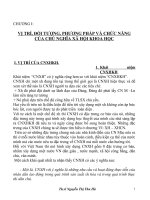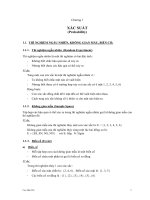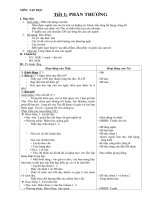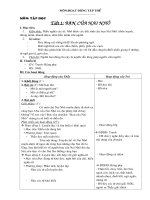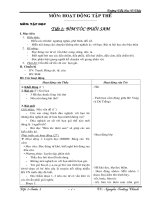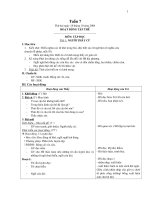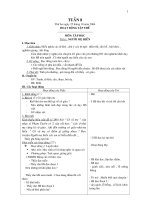NGC i
Bạn đang xem bản rút gọn của tài liệu. Xem và tải ngay bản đầy đủ của tài liệu tại đây (40.85 KB, 7 trang )
NGC banner
Guideline Summary NGC-8216
Guideline Title
Standards of medical care in diabetes. I. Classification and diagnosis of diabetes.
Bibliographic Source(s)
American Diabetes Association (ADA). Standards of medical care in diabetes. I. Classification and diagnosis of
diabetes. Diabetes Care 2011 Jan;34(Suppl 1):S12-3.
Guideline Status
Note: This guideline has been updated. The National Guideline Clearinghouse (NGC) is working to update this
summary.
Scope
Disease/Condition(s)
l
Diabetes mellitus (type I, type II, gestational, and diabetes due to other causes)
l
Prediabetes
Guideline Category
Diagnosis
Evaluation
Prevention
Risk Assessment
Screening
Clinical Specialty
Endocrinology
Family Practice
Geriatrics
Internal Medicine
Nursing
Obstetrics and Gynecology
Pediatrics
Intended Users
Advanced Practice Nurses
Allied Health Personnel
Dietitians
Health Care Providers
Health Plans
Hospitals
Managed Care Organizations
Nurses
Patients
Physician Assistants
Physicians
Public Health Departments
Guideline Objective(s)
To provide information on the classification of diabetes and recommendations for the diagnosis of diabetes
mellitus
l
To provide clinicians, patients, researchers, payers, and other interested individuals with the components of
diabetes care, general treatment goals, and tools to evaluate the quality of care
l
Target Population
Public Health Departments
Guideline Objective(s)
To provide information on the classification of diabetes and recommendations for the diagnosis of diabetes
mellitus
l
To provide clinicians, patients, researchers, payers, and other interested individuals with the components of
diabetes care, general treatment goals, and tools to evaluate the quality of care
l
Target Population
l
Children and adults with:
Type 1 diabetes
l
l
Type 2 diabetes
Other specific types of diabetes due to other causes, e.g., genetic defects in beta-cell function, genetic defects
in insulin action, diseases of the exocrine pancreas (such as cystic fibrosis), and drug- or chemical-induced diabetes
(such as in the treatment of acquired immunodeficiency syndrome [AIDS] or after organ transplantation)
l
l
l
Women with gestational diabetes mellitus (GDM)
Children and adults at increased risk for diabetes (prediabetes)
l
Impaired glucose tolerance (IGT)
l
Impaired fasting glucose (IFG)
Interventions and Practices Considered
Diagnosis/Evaluation
1. Hemoglobin A1C using a method certified by the National Glycohemoglobin Standardization Program (NGSP) and
standardized or traceable to the Diabetes Control and Complications Trial (DCCT) reference assay
2. Fasting plasma glucose (FPG)
3. Two-hour plasma glucose during a 75-g oral glucose tolerance test (OGTT)
4. Random plasma glucose
5. Evaluation of symptoms
Major Outcomes Considered
Sensitivity and specificity of diagnostic tests
Methodology
Methods Used to Collect/Select the Evidence
Searches of Electronic Databases
Description of Methods Used to Collect/Select the Evidence
Not stated
Number of Source Documents
Not stated
Methods Used to Assess the Quality and Strength of the Evidence
Weighting According to a Rating Scheme (Scheme Given)
Rating Scheme for the Strength of the Evidence
American Diabetes Association's Evidence Grading System for Clinical Practice Recommendations
A
Clear evidence from well-conducted, generalizable, randomized controlled trials that are adequately powered, including:
l
Evidence from a well-conducted multicenter trial
l
Evidence from a meta-analysis that incorporated quality ratings in the analysis
Compelling nonexperimental evidence (i.e., "all or none" rule developed by the Centre for Evidence-Based Medicine at
Oxford)
Supportive evidence from well-conducted randomized controlled trials that are adequately powered, including:
l
Evidence from a well-conducted trial at one or more institutions
l
Evidence from a meta-analysis that incorporated quality ratings in the analysis
B
Supportive evidence from well-conducted cohort studies, including:
l
Evidence from a well-conducted prospective cohort study or registry
l
Evidence from a well-conducted meta-analysis of cohort studies
Supportive evidence from a well-conducted case-control study
C
Supportive evidence from poorly controlled or uncontrolled studies, including:
Evidence from randomized clinical trials with one or more major or three or more minor methodological flaws that
could invalidate the results
l
B
Supportive evidence from well-conducted cohort studies, including:
l
Evidence from a well-conducted prospective cohort study or registry
l
Evidence from a well-conducted meta-analysis of cohort studies
Supportive evidence from a well-conducted case-control study
C
Supportive evidence from poorly controlled or uncontrolled studies, including:
Evidence from randomized clinical trials with one or more major or three or more minor methodological flaws that
could invalidate the results
l
Evidence from observational studies with high potential for bias (such as case series with comparison to historical
controls)
l
l
Evidence from case series or case reports
Conflicting evidence with the weight of evidence supporting the recommendation
E
Expert consensus or clinical experience
Methods Used to Analyze the Evidence
Review of Published Meta-Analyses
Systematic Review
Description of the Methods Used to Analyze the Evidence
Not stated
Methods Used to Formulate the Recommendations
Expert Consensus
Description of Methods Used to Formulate the Recommendations
Not stated
Rating Scheme for the Strength of the Recommendations
Not applicable
Cost Analysis
Published cost analyses were reviewed.
Method of Guideline Validation
Internal Peer Review
Description of Method of Guideline Validation
The recommendations were reviewed and approved by the Professional Practice Committee and, subsequently, by the
Executive Committee of the Board of Directors.
Recommendations
Major Recommendations
Note: This guideline has been updated. The National Guideline Clearinghouse (NGC) is working to update this
summary. The recommendations that follow are based on the previous version of the guideline.
Classification and Diagnosis
Diagnosis of Diabetes
Table: Criteria for the Diagnosis of Diabetes
Glycosylated hemoglobin (A1C) ≥6.5%. The test should be performed in a laboratory using a method that is National Glycohemoglobin
Standardization Program (NGSP) certified and standardized to the Diabetes Control and Complications Trial (DCCT) assay.*
or
Fasting plasma glucose (FPG) ≥126 mg/dL (7.0 mmol/L). Fasting is defined as no caloric intake for at least 8 h.*
or
Two-hour plasma glucose ≥200 mg/dL (11.1 mmol/L) during an oral glucose tolerance test (OGTT). The test should be performed as described by
the World Health Organization, using a glucose load containing the equivalent of 75 g anhydrous glucose dissolved in water.*
or
In a patient with classic symptoms of hyperglycemia or hyperglycemic crisis, a random plasma glucose ≥200 mg/dl (11.1 mmol/L).
*In the absence of unequivocal hyperglycemia, results should be confirmed by repeat testing.
Categories of Increased Risk for Diabetes (Prediabetes)
In 1997 and 2003, the Expert Committee on the Diagnosis and Classification of Diabetes Mellitus recognized an
intermediate group of individuals whose glucose levels, although not meeting criteria for diabetes, are nevertheless too
the World Health Organization, using a glucose load containing the equivalent of 75 g anhydrous glucose dissolved in water.*
or
In a patient with classic symptoms of hyperglycemia or hyperglycemic crisis, a random plasma glucose ≥200 mg/dl (11.1 mmol/L).
*In the absence of unequivocal hyperglycemia, results should be confirmed by repeat testing.
Categories of Increased Risk for Diabetes (Prediabetes)
In 1997 and 2003, the Expert Committee on the Diagnosis and Classification of Diabetes Mellitus recognized an
intermediate group of individuals whose glucose levels, although not meeting criteria for diabetes, are nevertheless too
high to be considered normal. This group was defined as having impaired fasting glucose (IFG) (FPG levels of 100
mg/dL to 125 mg/dL [5.6 mmol/L to 6.9 mmol/L]) or impaired glucose tolerance (IGT) (2-h PG values in the OGTT of
140 mg/dL to 199 mg/dL [7.8 mmol/L to 11.0 mmol/L]). It should be noted that the World Health Organization (WHO)
and a number of other diabetes organizations define the cutoff for IFG at 110 mg/dL (6.1 mmol/L).
Individuals with IFG and/or IGT have been referred to as having prediabetes, indicating the relatively high risk for the
future development of diabetes. IFG and IGT should not be viewed as clinical entities in their own right but rather as
risk factors for diabetes as well as cardiovascular disease (CVD).
Table. Categories of Increased Risk for Diabetes (Prediabetes)**
FPG 100–125 mg/dL (5.6–6.9 mmol/L): IFG
or
2-h PG on the 75-g OGTT 140–199 mg/dL (7.8–11.0 mmol/L): IGT
or
A1C 5.7% to 6.4%
**For all three tests, risk is continuous, extending below the lower limit of the range and becoming disproportionately greater at higher
ends of the range.
Clinical Algorithm(s)
None provided
Evidence Supporting the Recommendations
Type of Evidence Supporting the Recommendations
The type of supporting evidence is not specifically stated for each recommendation.
Benefits/Harms of Implementing the Guideline Recommendations
Potential Benefits
The recommendations included are diagnostic and therapeutic actions that are known or believed to favorably affect
health outcomes of patients with diabetes.
Potential Harms
Not stated
Qualifying Statements
Qualifying Statements
Evidence is only one component of clinical decision-making. Clinicians care for patients, not populations;
guidelines must always be interpreted with the needs of the individual patient in mind. Individual circumstances,
such as comorbid and coexisting diseases, age, education, disability, and, above all, patients' values and
preferences, must also be considered and may lead to different treatment targets and strategies. Also, conventional
evidence hierarchies, such as the one adapted by the American Diabetes Association, may miss some nuances that
are important in diabetes care. For example, while there is excellent evidence from clinical trials supporting the
importance of achieving glycemic control, the optimal way to achieve this result is less clear. It is difficult to assess
each component of such a complex intervention.
l
While individual preferences, comorbidities, and other patient factors may require modification of goals, targets
that are desirable for most patients with diabetes are provided. These standards are not intended to preclude clinical
judgment or more extensive evaluation and management of the patient by other specialists as needed.
l
Implementation of the Guideline
Description of Implementation Strategy
While numerous interventions to improve adherence to the recommended standards have been implemented, a major
contributor to suboptimal care is a delivery system that too often is fragmented, lacks clinical information capabilities,
often duplicates services, and is poorly designed for the delivery of chronic care. The Chronic Care Model (CCM) includes
six core elements for the provision of optimal care of patients with chronic disease: 1) delivery system design (moving
from a reactive to a proactive care delivery system, where planned visits are coordinated through a team-based
approach; 2) self-management support; 3) decision support (basing care on consistent, effective care guidelines); 4)
clinical information systems (using registries that can provide patient-specific and population-based support to the care
team); 5) community resources and policies (identifying or developing resources to support healthy lifestyles); and 6)
health systems (to create a quality-oriented culture). Alterations in reimbursement that reward the provision of quality
Implementation of the Guideline
Description of Implementation Strategy
While numerous interventions to improve adherence to the recommended standards have been implemented, a major
contributor to suboptimal care is a delivery system that too often is fragmented, lacks clinical information capabilities,
often duplicates services, and is poorly designed for the delivery of chronic care. The Chronic Care Model (CCM) includes
six core elements for the provision of optimal care of patients with chronic disease: 1) delivery system design (moving
from a reactive to a proactive care delivery system, where planned visits are coordinated through a team-based
approach; 2) self-management support; 3) decision support (basing care on consistent, effective care guidelines); 4)
clinical information systems (using registries that can provide patient-specific and population-based support to the care
team); 5) community resources and policies (identifying or developing resources to support healthy lifestyles); and 6)
health systems (to create a quality-oriented culture). Alterations in reimbursement that reward the provision of quality
care, as defined by the attainment of evidence-based quality measures, will also be required to achieve desired
outcome goals. Redefinition of the roles of the clinic staff and promoting self-management on the part of the patient
are fundamental to the successful implementation of the CCM. Collaborative, multidisciplinary teams are best suited to
provide such care for people with chronic conditions like diabetes and to facilitate patients' performance of appropriate
self-management.
A rapidly evolving literature suggests that there are three major strategies to successfully improve the quality of
diabetes care delivered by a team of providers. National Diabetes Education Program (NDEP) maintains an online
resource (www.betterdiabetescare.nih.gov
) to help health care professionals design and implement more effective
health care delivery systems for those with diabetes.
Three specific objectives are outlined below.
Objective 1
Provider and team behavior change: Facilitate timely and appropriate intensification of lifestyle and/or pharmaceutical
therapy of patients who have not achieved beneficial levels of blood pressure, lipid, or glucose control.
Clinical information systems including registries that can prospectively identify and track those requiring
assessments and/or treatment modifications by the team.
l
Electronic medical record-based clinical decision support at the point of care, both personalize and standardize
care and can be used by multiple providers.
l
l
Use of checklists and/or flow sheets that mirror guidelines.
Detailed treatment algorithms enabling multiple team members to "treat to target" and appropriately intensify
therapy.
l
Availability of care or disease management service by nurses, pharmacists, and other providers using detailed
algorithms often catalyzing reduction in A1C, blood pressure, and low-density lipoprotein (LDL) cholesterol.
l
Objective 2
Patient behavior change: Implement a systematic approach to support patients' behavior change efforts as needed
including 1) healthy lifestyle (physical activity, healthy eating, nonuse of tobacco, weight management, effective
coping, medication taking and management); 2) prevention of diabetes complications (screening for eye, foot, and
renal complications; immunizations); and 3) achievement of appropriate blood pressure, lipid, and glucose goals.
Delivery of high-quality diabetes self-management education (DSME), which has been shown to improve patient
self-management, satisfaction, and glucose control.
l
Delivery of ongoing diabetes self-management support (DSMS) to ensure that gains achieved during DSME are
sustained. National DSME standards call for an integrated approach that includes clinical content and skills,
behavioral strategies (goal-setting, problem solving), and addressing emotional concerns in each needed curriculum
content area. Provision of continuing education and support (DSMS) improves maintenance of gains regardless of the
educational methodology.
l
l
Provision of automated reminders via multiple communication channels to various subgroups of diabetic patients.
Objective 3
Change the system of care: Research on the comprehensive CCM suggests additional strategies to improve diabetes
care, including the following:
l
Basing care on consistent, evidence-based care guidelines
l
Redefining and expanding the roles of the clinic staff
Collaborative, multidisciplinary teams to provide high-quality care and support patients' appropriate selfmanagement
l
Audit and feedback of process and outcome data to providers to encourage population-based care improvement
strategies
l
l
Care management, one of the most effective diabetes quality improvement strategies to improve glycemic control
l
Identifying and/or developing community resources and public policy that support healthy lifestyles
Alterations in reimbursement that reward the provision of appropriate and high-quality care and accommodate the
need to personalize care goals, providing additional incentives to improve diabetes care
l
The most successful practices have an institutional priority for quality of care, expanding the role of teams and staff,
redesigning their delivery system, activating and educating their patients, and using electronic health record tools.
Recent initiatives such as the Patient Centered Medical Home show promise in improving outcomes through coordinated
primary care and offer new opportunities for team-based chronic disease care.
It is clear that optimal diabetes management requires an organized, systematic approach and involvement of a
coordinated team of dedicated health care professionals working in an environment where patient-centered high-quality
care is a priority.
Implementation Tools
Personal Digital Assistant (PDA) Downloads
Quick Reference Guides/Physician Guides
Slide Presentation
For information about availability, see the Availability of Companion Documents and Patient Resources fields below.
Implementation Tools
Personal Digital Assistant (PDA) Downloads
Quick Reference Guides/Physician Guides
Slide Presentation
For information about availability, see the Availability of Companion Documents and Patient Resources fields below.
Institute of Medicine (IOM) National Healthcare Quality Report Categories
IOM Care Need
Living with Illness
Staying Healthy
IOM Domain
Effectiveness
Identifying Information and Availability
Bibliographic Source(s)
American Diabetes Association (ADA). Standards of medical care in diabetes. I. Classification and diagnosis of
diabetes. Diabetes Care 2011 Jan;34(Suppl 1):S12-3.
Adaptation
Not applicable: The guideline was not adapted from another source.
Date Released
1988 (revised 2011 Jan)
Guideline Developer(s)
American Diabetes Association - Professional Association
Source(s) of Funding
American Diabetes Association (ADA)
Guideline Committee
Professional Practice Committee
Composition of Group That Authored the Guideline
Committee Members: John Anderson, MD; John Buse, MD, PhD; Martha Funnell; Robert Gabbay, MD; Silvio Inzucchi
(Chairman); Jane Kadohiro, DrPH, APRN, CDE; Daniel Lorber, MD; Michelle Magee, MD; Sunder Mudaliar, MD; Patrick
O'Connor, MD, MPH; Peter Reaven, MD; Susan Braithwaite, MD; Guillermo Umpierrez, MD; Stuart Weinzimer, MD; Carol
Wysham, MD; Gretchen Youssef, MS, RD, CDE; Judy Fradkin, MD (Ex officio); Stephanie Dunbar, RD, MPH (Staff); Sue
Kirkman, MD (Staff)
Financial Disclosures/Conflicts of Interest
All members of the Professional Practice Committee are required to disclose potential conflicts of interest.
Conflict of interest disclosures for the 2010 Professional Practice Committee Members are available from the American
Diabetes Association (ADA) Web site (see "Availability of Companion Documents" field).
Guideline Status
Note: This guideline has been updated. The National Guideline Clearinghouse (NGC) is working to update this
summary.
Guideline Availability
Electronic copies of the updated guideline: Available from the American Diabetes Association (ADA) Web site
.
Print copies: Available from the American Diabetes Association, 1701 North Beauregard Street, Alexandria, VA 22311.
Availability of Companion Documents
The following are available:
l
Introduction. Diabetes Care 34:S1-S2, 2011.
l
Summary of revisions for the 2011 clinical practice recommendations. Diabetes Care 34:S3, 2011.
l
Executive summary: standards of medical care in diabetes. Diabetes Care 34:S4-S10, 2011.
Professional Practice Committee Members (includes conflict of interest disclosure). Diabetes Care 34:S97-S98,
2011.
l
Electronic copies: Available from the American Diabetes Association (ADA) Web site
.
Print copies: Available from the American Diabetes Association, 1701 North Beauregard Street, Alexandria, VA 22311.
l
Introduction. Diabetes Care 34:S1-S2, 2011.
l
Summary of revisions for the 2011 clinical practice recommendations. Diabetes Care 34:S3, 2011.
l
Executive summary: standards of medical care in diabetes. Diabetes Care 34:S4-S10, 2011.
Professional Practice Committee Members (includes conflict of interest disclosure). Diabetes Care 34:S97-S98,
2011.
l
Electronic copies: Available from the American Diabetes Association (ADA) Web site
.
Print copies: Available from the American Diabetes Association, 1701 North Beauregard Street, Alexandria, VA 22311.
The following are also available:
l
Diagnosis and classification of diabetes mellitus. Diabetes Care 2011 Jan; 34(Suppl 1):S62-S69, 2011. Electronic
copies: Available from the ADA Web site
l
.
2011 Standards of medical care in diabetes. Clinical practice recommendations. Slide set. American Diabetes
Association; 2011 Jan. 130 p. Electronic copies: Available from the ADA Web site
l
.
2011 Standards of medical care in diabetes. Clinical practice recommendations. Personal Digital Assistant (PDA).
American Diabetes Association; 2011 Jan. Electronic copies: Available for download from the ADA Web site
.
Patient Resources
None available
NGC Status
This summary was completed by ECRI on April 2, 2001. The information was verified by the guideline developer on
August 24, 2001. This summary was updated by ECRI on March 14, 2002, July 29, 2003, May 26, 2004, July 1, 2005,
March 16, 2006 and April 24, 2007. This summary was updated by ECRI Institute on March 14, 2008. The updated
information was verified by the guideline developer on May 15, 2008. This summary was updated by ECRI Institute on
May 19, 2010. The information was verified by the guideline developer on May 25, 2010. This summary was updated by
ECRI Institute on February 24, 2011.
Copyright Statement
This NGC summary is based on the original guideline, which is copyrighted by the American Diabetes Association
(ADA).
For information on guideline reproduction, please contact Alison Favors, Manager, Rights and Permissions by e -mail at
For information about the use of the guidelines, please contact the Clinical Affairs Department at (703) 549-1500 ext.
1692.
Disclaimer
NGC Disclaimer
The National Guideline Clearinghouse™ (NGC) does not develop, produce, approve, or endorse the guidelines
represented on this site.
All guidelines summarized by NGC and hosted on our site are produced under the auspices of medical specialty
societies, relevant professional associations, public or private organizations, other government agencies, health care
organizations or plans, and similar entities.
Guidelines represented on the NGC Web site are submitted by guideline developers, and are screened solely to
determine that they meet the NGC Inclusion Criteria which may be found at />NGC, AHRQ, and its contractor ECRI Institute make no warranties concerning the content or clinical efficacy or
effectiveness of the clinical practice guidelines and related materials represented on this site. Moreover, the views and
opinions of developers or authors of guidelines represented on this site do not necessarily state or reflect those of
NGC, AHRQ, or its contractor ECRI Institute, and inclusion or hosting of guidelines in NGC may not be used for
advertising or commercial endorsement purposes.
Readers with questions regarding guideline content are directed to contact the guideline developer.
